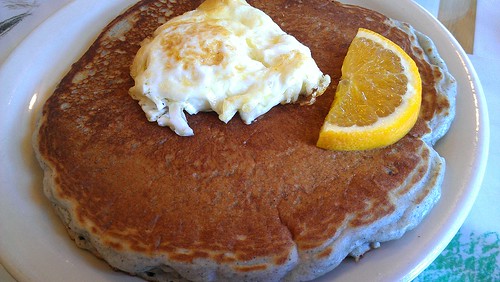
This one's dedicated to my Santa Fe friends.
If you've ever been to Santa Fe, New Mexico, you know that it is a special place indeed. The food reflect's the city's "tri-cultural" background: Native American, Mexican, and Spanish. With, of course, a touch of modern hippie and crystal-chaser in the mix. It makes for an interesting food scene, to say the least. (for my ultimate review of New Mexico sweets, check out this post!)

Two ingredients which are in frequent rotation in both baked goods and savories alike are blue corn and piñon nuts (pine nuts), respectively. One beautiful example of a delicious fusion of these ingredients was found in the beyond-locally famous atole-piñon pancakes served at Tecolote Cafe, a funky little breakfast place on Cerillos Road that is famous for their "no toast" policy.
Well, me and everyone in Santa Fe was saddened when Tecolote shuttered their doors earlier this year due to a lease matter. I mourned those pancakes.
Well, I am happy to say that Tecolote has found a new home and will be re-opening soon. In the meantime, I will "toast" them with a food that is inspired by them but that will never-ever appear on their menu: blue corn piñon bread.

Made with part blue corn flour and plenty of buttery piñon both in the bread and on top, this is a beautiful loaf with a novel, slightly blue-purple tint when looked at from the right angle. Taste-wise, it's lightly nutty; the blue corn gives it an intriguing, earthy taste. With mellow little lumps of rich piñon punctuating every bite, it's an absolute delight served with butter and a little salt.

Since it's made with whole wheat flour, too, it has a firm enough structure so that it is also appropriate for any type of dish you'd make with sandwich bread.

Blue Corn Pinon Bread
Adapted from King Arthur Flour
Yield: 1 large loaf
- 2 cups lukewarm water
- 2 1/4 teaspoons instant yeast (1 packet)
- 1 tablespoon honey
- 2 teaspoons salt
- 3 tablespoons soft butter
- 3 cups whole wheat flour, sifted
- 1 cup blue corn flour, sifted
- 1/4 to 1/2 cup piñon, to taste
Procedure
- Combine the water and yeast. Once the yeast begins to bubble lightly, proceed.
- Mix all of the remaining ingredients with the yeast mixture in the order listed, reserving 1/4 of the piñon to top the bread later.
- Knead, either by hand with a dough scraper or with a stand mixer, until it has progressed past a shaggy texture to a solid, slightly sticky mass. This can take up to 5 minutes by hand; less when using a mixer. It will never quite take on the smooth elasticity of wheat flour-only bread, but the extra moisture is necessary as the whole grains will absorb it. Place the dough into a lightly greased bowl, cover it, and let it rise at room temperature until it’s quite puffy and doubled in size, 1 to 2 hours.
- Gently deflate the dough with your hand (a gentle pressing, not a knockout punch), and shape it into a fat 9″ log (it may still be slightly sticky; I used lightly oiled hands). Place it in a lightly greased 9″ x 5″ loaf pan. Sprinkle remaining piñon on top.
- Cover the pan, and let the dough rise for 2 hours or even overnight, or until it has formed a crown which extends 1 inch or slightly more over the rim of the pan. Toward the end of the rising time, preheat the oven to 350°F.
- Bake the bread uncovered for 20 minutes. Tent it lightly with aluminum foil, and bake for an additional 15 to 20 minutes, or until it is golden brown on top, and when knocked lightly, yields a slightly hollow sound.
- Remove the bread from the oven, and turn it out onto a rack to cool. When completely cool, wrap in plastic, and store at room temperature.
